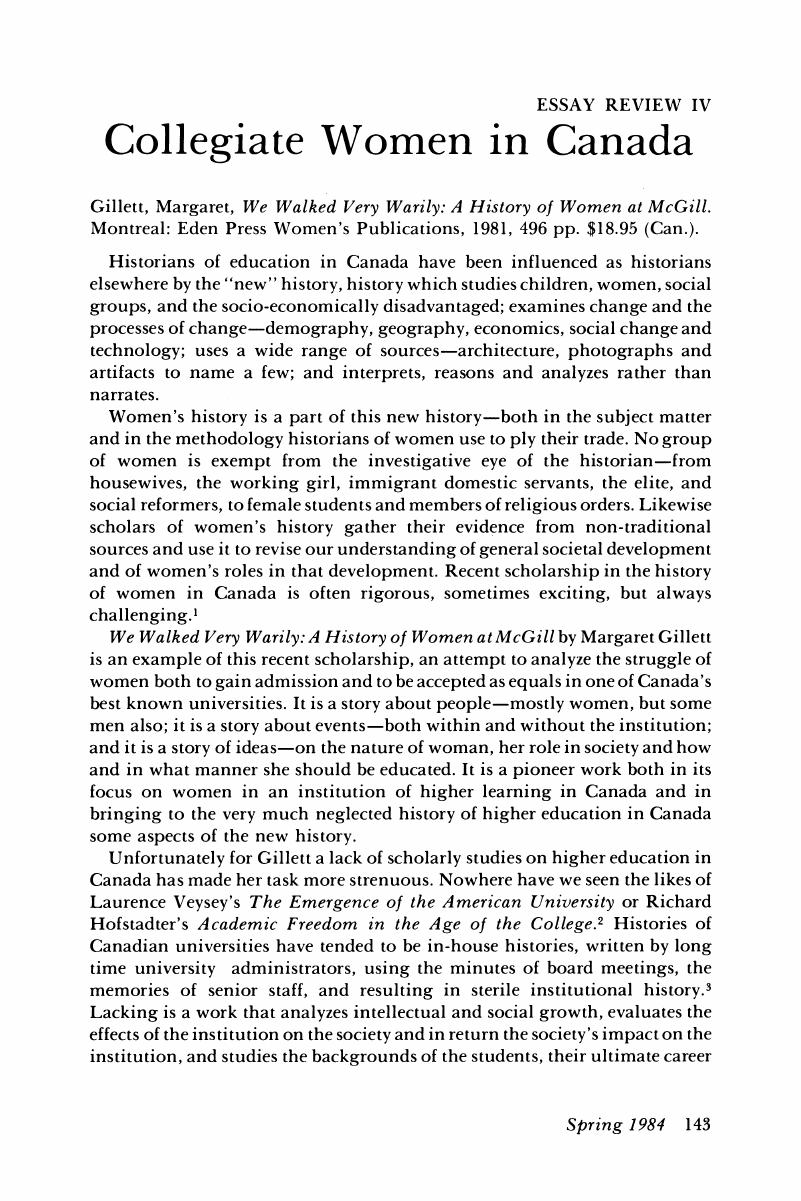No CrossRef data available.
Published online by Cambridge University Press: 24 February 2017

1. It would be impossible to list all the challenging work being produced in Canada. I would direct readers to: Silverman, Elaine Leslau, “Writing Canadian Women's History, 1970–82: an Historiographical Analysis” Canadian Historical Review, 63:4(1982):513–533.Google Scholar
2. Veysey, Laurence, The Emergence of the American University (Chicago, 1965); Hofstadter, Richard, Academic Freedom in the Age of the College (New York, 1955); Rudolph, Frederick, The American College and University: A History (New York, 1962).Google Scholar
3. See, for example, Frost, Stanley Brice, McGill University: For the Advancement of Learning, Vol. 1, 1801–1895 (Montreal, 1980); Neatby, Hilda, Queen's University, Vol. 1:1841–1917 (Montreal, 1978) Bedford, A.G., The University of Winnipeg: A History of the Founding Colleges (Toronto, 1976) Johns, Walter H., A History of the University of Alberta 1908–1969 (Edmonton, 1981). See also Harris, Robin S., A History of Higher Education in Canada, 1663–1960 (Toronto, 1976). The only university histories outside this “in house” tradition are Johnston, Charles M., McMaster University: 1/ The Toronto Years (Toronto, 1976) and McMaster University: 2/ The Early Years in Hamilton, 1930–1957 (Toronto, 1981) and Gibson, Frederick W., Queen's University Vol. II:1917–1961 (Kingston and Montreal, 1983). For critiques of Canadian university histories see Axelrod, Paul, “Higher Education in Canada,” History of Education Quarterly, 19:2 (Summer 1979) and “Historical Writing and Canadian Universities: The State of the Art,” Queens Quarterly (Spring 1982).Google Scholar
4. See also Gillett, Margaret, “Leacock and the Ladies of R.V.C.” McGill Journal of Education 16, 2 (Spring, 1918): 121–129.Google Scholar
5. In Ontario much of the grammer school debate on the admission of women focussed on the study of Latin, and Ryerson tried a number of schemes which would admit girls to an “English only” program, thus precluding their acceptance at universities. See Royce, Marion V., “Arguments over the Education of Girls—Their Admission to Grammar Schools in This Province. Ontario History, 67 (March, 1975):2–13. Montreal did not have a public girls' high school until 1875 and then the curriculum did not include all university entrance subjects.Google Scholar
6. See Porter, John, The Vertical Mosaic: An Analysis of Social Class and Power in Canada (Toronto, 1965) and Porter, John, Porter, Marian and Blishen, Bernard et al, Stations and Callings: Making It Through the School System (Toronto, 1982).Google Scholar
7. Jennifer Brown, M., “‘A Disposition to Bear the Ills …’: Rejection of a Separate College by University of Toronto Women.” The Women in Canadian History Project, Department of History and Philosophy of Education, Ontario Institute for Studies in Education, n.d. Google Scholar
8. Frost, , McGill University, p. 183.Google Scholar
9. Burstyn, Joan N., Victorian Education and the Ideal of Womanhood (London, 1980), p. 11.Google Scholar
10. Danylewycz, Marta, “Changing Relationships: Nuns and Feminists in Montreal, 1890–1925” Histoire Sociale—Social History, 14, 28 (November, 1981):413–434, and Frost, Stanley Brice, McGill University. pp. 172–174.Google Scholar
11. McKillop, A.B., A Disciplined Intelligence: Critical Inquiry and Canadian Thought in the Victorian Era (Montreal, 1979).Google Scholar
12. Royce, Marion V., “Education for Girls in Quaker Schools in Ontario,” Atlantis, 3:1, Part 1 (Spring, 1978): 181–192.Google Scholar
13. Reid, John G., “The Education of Women at Mount Allison, 1854–1914: The Clash of Academic and ‘Ornamental’ Traditions,” Paper read at Canadian Historical Association Annual Meeting, Ottawa, June 1982.Google Scholar
14. Rudolph, Frederick, The American College and University, p. 323.Google Scholar
15. Stamp, Robert M., “Teaching Girls their “God Given Place in Life”: The Introduction of Home Economics in the Schools,” Atlantis 2:2 (Spring, 1977).Google Scholar